Submarine Depositional Terraces at Salina Island (Southern Tyrrhenian Sea) and Implications on the Late-Quaternary Evolution of the Insular Shelf
Abstract
:1. Introduction
2. Data and Methods
3. Geological Setting
4. Results
4.1. Overall Morphology and Seismo-Stratigraphic Architecture of the Salina Insular Shelf
4.2. Submarine Depositional Terraces
5. Discussion
5.1. Late-Quaternary Evolution of Insular Shelf and Overlying Submarine Depositional Terrace
5.2. Submarine Depositional Terraces as a Tool for the Assessment of Vertical Movements and Relative Dating of Erosive Activity of Canyons
6. Final Remarks
Acknowledgments
Author Contributions
Conflicts of Interest
References
- Mitchell, N.C.; Masson, D.G.; Watts, A.B.; Gee, M.J.R.; Urgeles, R. The morphology of the submarine flanks of volcanic ocean islands. A comparative study of the Canary and Hawaiian hotspot islands. J. Volcanol. Geothe. Res. 2002, 115, 83–107. [Google Scholar] [CrossRef]
- Coussens, M.; Wall-Palmer, D.; Talling, P.J.; Watt, S.F.L.; Cassidy, M.; Jutzeler, M.; Clare, M.A.; Hunt, J.E.; Manga, M.; Gernon, T.M.; et al. The relationship between eruptive activity, flank collapse, and sea level at volcanic islands: A long-term >1(Ma) record offshore Montserrat, Lesser Antilles. Geochem. Geophys. Geosyst. 2016, 17, 2591–2611. [Google Scholar] [CrossRef]
- Coombs, M.L.; White, S.M.; Scholl, D.W. Massive edifice failure at Aleutian Arc volcanoes. Earth Planet. Sci. Lett. 2007, 256, 403–418. [Google Scholar] [CrossRef]
- Romagnoli, C.; Casalbore, D.; Bortoluzzi, G.; Bosman, A.; Chiocci, F.L.; D’Oriano, F.; Gamberi, F.; Ligi, M.; Marani, M. Bathy-morphological setting of the Aeolian Islands. In The Aeolian Islands Volcanoes; Geological Society of London: London, UK, 2013; pp. 27–36. [Google Scholar]
- Nomikou, P.; Papanikolaou, D.; Alexandri, M.; Sakellariou, D.; Rousakis, G. Submarine volcanoes along the Aegean volcanic arc. Tectonophysics 2013, 597, 123–146. [Google Scholar] [CrossRef]
- Bosman, A.; Casalbore, D.; Romagnoli, C.; Chiocci, F.L. Formation of an ‘a’ā lava delta: Insights from time-lapse multibeam bathymetry and direct observations during the Stromboli 2007 eruption. Bull. Volcanol. 2014, 76. [Google Scholar] [CrossRef]
- Casalbore, D.; Romagnoli, C.; Pimentel, A.; Quartau, R.; Casas, D.; Ercilla, G.; Hipolito, A.; Sposato, A.; Chiocci, F.L. Volcanic, tectonic andmass-wasting processes offshore Terceira island (Azores) revealed by high-resolution seafloor mapping. Bull. Volcanol. 2015, 77. [Google Scholar] [CrossRef]
- Casalbore, D.; Bosman, A.; Romagnoli, C.; Chiocci, F.L. Large-scale seafloor waveforms on the flanks of insular volcanoes (Aeolian Archipelago, Italy), with inferences about their origin. Mar. Geol. 2014, 355, 318–329. [Google Scholar] [CrossRef]
- Urgeles, R.; Canals, M.; Baraza, J.; Alonso, B.; Masson, D. The most recent megalandslides of the Canary Islands: El Golfo debris avalanche and Canary debris flow, west El Hierro Island. J. Geophys. Res. Solid Earth 1997, 102, 20305–20323. [Google Scholar] [CrossRef]
- Oehler, J.F.; Lénat, J.F.; Labazuy, P. Growth and collapse of the Reunion Island volcanoes. Bull. Volcanol. 2008, 70, 712–742. [Google Scholar] [CrossRef]
- Silver, E.; Day, S.; Ward, S.; Hoffmann, G.; Llanes, P.; Driscoll, N.; Appelgate, B.; Saunders, S. Volcano collapse and tsunami generation in the Bismarck Volcanic Arc Papua New Guinea. J. Volcanol. Geotherm. Res. 2009, 186, 210–222. [Google Scholar] [CrossRef]
- Casalbore, D.; Romagnoli, C.; Bosman, A.; Chiocci, F.L. Potential tsunamigenic landslides at Stromboli Volcano (Italy): Insight from marine DEM analysis. Geomorphology 2011, 126, 42–50. [Google Scholar] [CrossRef]
- Quartau, R.; Trenhaile, A.S.; Mitchell, N.C.; Tempera, F. Development of volcanic insular shelves: Insights from observations and modelling of Faial Island in the Azores Archipelago. Mar. Geol. 2010, 275, 66–83. [Google Scholar] [CrossRef]
- Quartau, R.; Hipolito, A.; Romagnoli, C.; Casalbore, D.; Madeira, J.; Tempera, F.; Roque, C.; Chiocci, F.L. The morphology of insular shelves as a key for understanding the geological evolution of volcanic islands: Insights from Terceira Island (Azores). Geochem. Geophy. Geosyst. 2014, 15, 1801–1826. [Google Scholar] [CrossRef]
- Romagnoli, C. Characteristics and morphological evolution of the Aeolian volcanoes from the study of submarine portions. In The Aeolian Islands Volcanoes; Geological Society of London: London, UK, 2013; pp. 13–26. [Google Scholar]
- Romagnoli, C.; Jakobsson, S.P. Post-eruptive morphological evolution of island volcanoes: Surtsey as a modern case study. Geomorphology 2015, 250, 384–396. [Google Scholar] [CrossRef]
- Romagnoli, C.; Casalbore, D.; Ricchi, A.; Lucchi, F.; Quartau, R.; Bosman, A.; Tranne, C.A.; Chiocci, F.L. Morpho-bathymetric and seismo-stratigraphic analysis of the insular shelf of Salina (Aeolian archipelago) to unveil its Late-Quaternary geological evolution. Mar. Geol. 2018, 395, 133–151. [Google Scholar] [CrossRef]
- Chiocci, F.L.; Orlando, L. Lowstand terraces on Tyrrhenian Sea steep continental slopes. Mar. Geol. 1996, 134, 127–143. [Google Scholar] [CrossRef]
- Pepe, F.; Bertotti, G.; Ferranti, L.; Sacchi, M.; Collura, A.M.; Passaro, S.; Sulli, A. Pattern and rate of post-20 ka vertical tectonic motion around the Capo Vaticano Promontory (W Calabria, Italy) based on offshore geomorphological indicators. Quat. Int. 2014, 322, 85–98. [Google Scholar] [CrossRef] [Green Version]
- Casalbore, D.; Falese, F.; Martorelli, E.; Romagnoli, C.; Chiocci, F.L. Submarine depositional terraces in the Tyrrhenian Sea as a proxy for paleo-sea level reconstruction: Problems and perspective. Quat. Int. 2017, 439, 169–180. [Google Scholar] [CrossRef]
- Lobo, F.J.; Fernandez-Salas, L.M.; Hernandez-Molina, F.J.; Gonzalez, R.; Dias, J.M.A.; Díaz del Río, V.; Somoza, L. Holocene highstand deposits in the Gulf of Cadiz, SW Iberian Peninsula: A high-resolution record of environmental changes. Mar. Geol. 2005, 219, 119–141. [Google Scholar] [CrossRef]
- Chiocci, F.L.; Romagnoli, C. Terrazzi Deposizionali Sommersi Nelle Isole Eolie. Available online: http://www.isprambiente.gov.it/contentfiles/00002400/2434-terrazzi-chiocci3.zip/at_download/file (accessed on 10 December 2017).
- Mitchell, N.C.; Masselink, G.; Huthnance, J.M.; Fernandez-Salas, L.M.; Lobo, F.J. Depths of modern coastal sand clinoforms. J. Sediment. Res. 2012, 82, 469–481. [Google Scholar] [CrossRef]
- Bosman, A.; Casalbore, D.; Anzidei, M.; Muccini, F.; Carmisciano, C.; Chiocci, F.L. The first ultra-high resolution digital Terrain model of the shallow-water sector around Lipari Island (Aeolian Islands, Italy). Ann. Geophys. 2015, 58, 771–787. [Google Scholar]
- Ventura, G. Kinematics of the Aeolian volcanism (Southern Tyrrhenian Sea) from geophysical and geological data. In The Aeolian Islands Volcanoes; Geological Society of London: London, UK, 2013; pp. 3–11. [Google Scholar]
- Lucchi, F.; Gertisser, R.; Keller, J.; Forni, F.; De Astis, G.; Tranne, C.A. Eruptive history and magmatic evolution of the island of Salina (central Aeolian archipelago). In The Aeolian Islands Volcanoes; Geological Society of London: London, UK, 2013; pp. 155–211. [Google Scholar]
- Casalbore, D.; Bosman, A.; Romagnoli, C.; Chiocci, F.L. Morphological map of Salina offshore (Southern Tyrrhenian Sea). J. Maps 2016, 12, 725–730. [Google Scholar] [CrossRef]
- Chiocci, F.L. Distorsioni nella forma dei TDS rilevati dai profili sismici e ripristino delle corrette geometrie (migrazione). In Atlante dei Terrazzi Deposizionali Sommersi Lungo le Coste Italiane; Memorie Descrittive della Carta Geologica d’Italia: Roma, Italy, 2004. [Google Scholar]
- Bintanja, R.; van de Wal, R.S.W.; Oerlemans, J. Modelled atmospheric temperatures and global sea levels the past million years. Nature 2005, 437, 125–128. [Google Scholar] [CrossRef] [PubMed]
- Casalbore, D.; Bosman, A.; Martorelli, E.; Sposato, A.; Chiocci, F.L. Mass-wasting features on the submarine flanks of Ventotene volcanic edifice (Tyrrhenian Sea, Italy). In Submarine Mass Movements and Their Consequences, 6th International Symposium; Springer: Berlin, Germany, 2016. [Google Scholar]
- Hernandez-Molina, F.J.; Fernandez-Salas, L.M.; Lobo, F.J.; Somoza, L.; Díaz del Río, V.; Alveirinho Dias, J.M. The infralittoral prograding wedge: A new largescale progradational sedimentary body in shallow marine environments. Geo-Mar. Lett. 2000, 20, 109–117. [Google Scholar] [CrossRef]
- Chiocci, F.L.; Casalbore, D. Unexpected fast rate of morphological evolution of geologically-active continental margins during Quaternary: Examples from selected areas in the Italian seas. Mar. Pet. Geol. 2017, 82, 154–162. [Google Scholar] [CrossRef]
- Bárcenas, P.; Lobo, F.J.; Macías, J.; Fernández-Salas, L.M.; López-González, N.; Díaz del Río, V. Submarine deltaic geometries linked to steep, mountainous drainage basins in the northern shelf of the Alboran Sea: Filling the gaps in the spectrum of deltaic deposition. Geomorphology 2015, 232, 125–144. [Google Scholar] [CrossRef]
- Lambeck, K.; Antonioli, F.; Anzidei, M.; Ferranti, L.; Leoni, G.; Scicchitano, G.; Silenzi, S. Sea level change along the Italian coast during the Holocene and projections for the future. Quat. Int. 2011, 232, 250–257. [Google Scholar] [CrossRef]
- Budillon, F.; Esposito, E.; Iorio, M.; Pelosi, N.; Porfido, S.; Violante, C. The geological record of storm events over the last 1000 years in the Salerno Bay (Southern Tyrrhenian Sea): New proxy evidences. Adv. Geosci. 2005, 2, 123–130. [Google Scholar] [CrossRef]
- Sabatier, P.; Dezileau, L.; Colin, C.; Briqueu, L.; Bouchette, F.; Martinez, P.; Siani, G.; Raynal, O.; Von Grafenstein, U. 7000 years of paleostorm activity in the NW Mediterranean Sea in response to Holocene climate events. Quat. Res. 2012, 77, 1–11. [Google Scholar] [CrossRef]
- Trincardi, F.; Field, M.E. Geometry, lateral variation, and preservation of downlapping regressive shelf deposits: Eastern Tyrrhenian Sea margin, Italy. J. Sediment. Petrol. 1991, 61, 775–790. [Google Scholar]
- Anzidei, M.; Esposito, M.; Benini, M. Evidence of active subsidence at Basiluzzo island (Aeolian islands, southern Italy) inferred from a Roman age wharf. Quat. Int. 2014, 288, 158–167. [Google Scholar] [CrossRef]
- Calanchi, N.; Lucchi, F.; Pirazzoli, P.; Romagnoli, C.; Tranne, C.A.; Radtke, U.; Reyss, J.L.; Rossi, P.L. Late Quaternary relative sea-level changes and vertical movements at Lipari (Aeolian islands). J. Quat. Sci. 2002, 17, 459–467. [Google Scholar] [CrossRef]
- Anzidei, M.; Bosman, A.; Casalbore, D.; Tusa, S.; La Rocca, R. New insights on the subsidence of Lipari island (Aeolian islands, southern Italy) from the submerged Roman age pier at Marina Lunga. Quat. Int. 2016, 401, 162–173. [Google Scholar] [CrossRef]
- Anzidei, M.; Bosman, A.; Carluccio, R.; Casalbore, D.; D’Ajello, C.F.; Esposito, A.; Nicolosi, I.; Pietrantonio, G.; Vecchio, A.; Carmisciano, C.; et al. Flooding scenarios in coastal volcanic areas due to land subsidence and sea level rise: A case study for Lipari Island (Italy). Terra Nova 2017, 29, 44–51. [Google Scholar] [CrossRef]
- Casalbore, D.; Romagnoli, C.; Bosman, A.; Anzidei, M.; Chiocci, F.L. Coastal hazard due to submarine canyons in active insular volcanoes: Examples from Lipari Island (southern Tyrrhenian Sea). J. Coast. Conserv. 2017, 6, 1–11. [Google Scholar] [CrossRef]
- Casalbore, D.; Bosman, A.; Chiocci, F.L. Study of recent small-scale landslides in geologically active marine areas through repeated multibeam surveys: Examples from the Southern Italy. In Submarine Mass Movement and Their Consequences; Springer: Berlin, Germany, 2012. [Google Scholar]
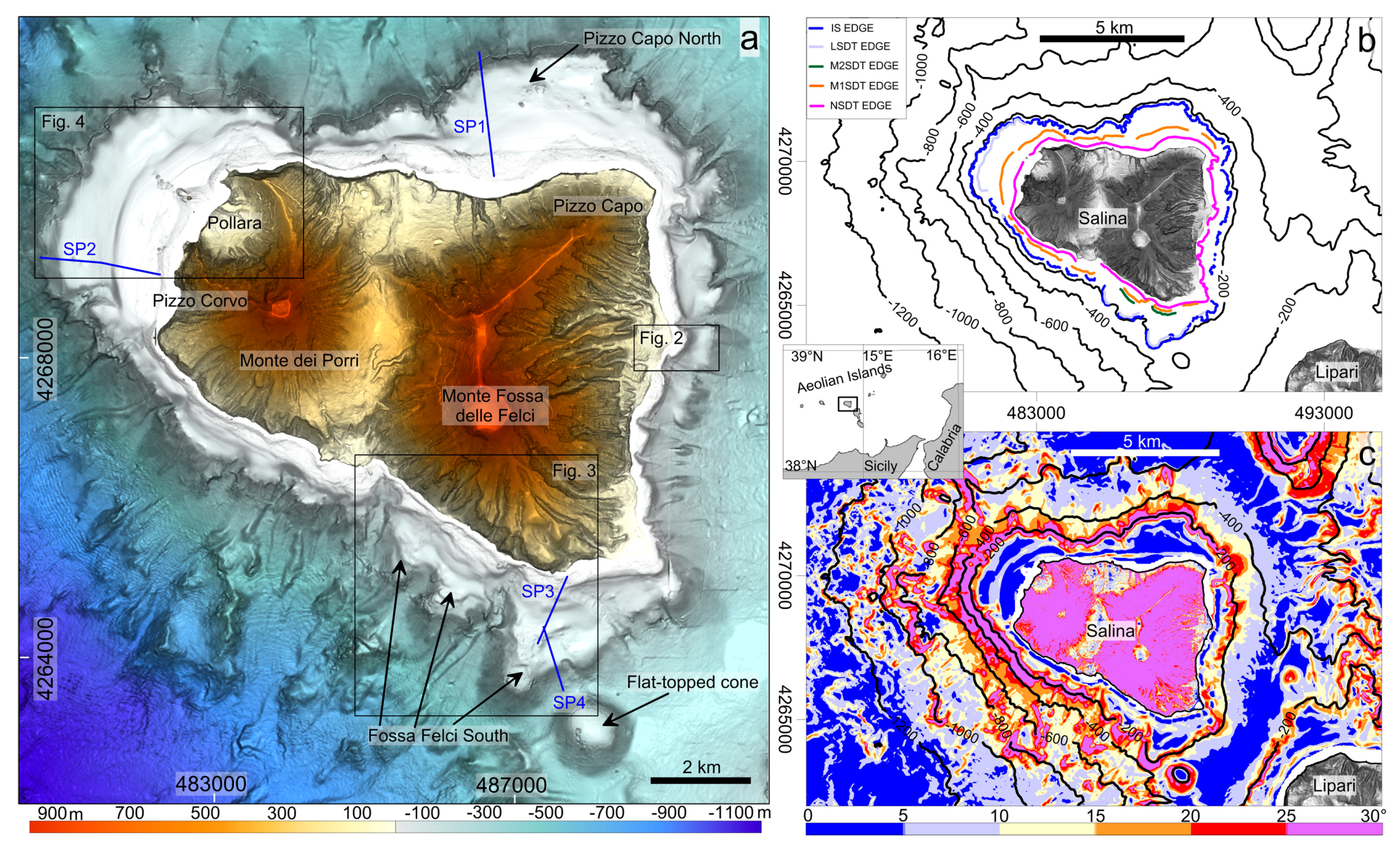
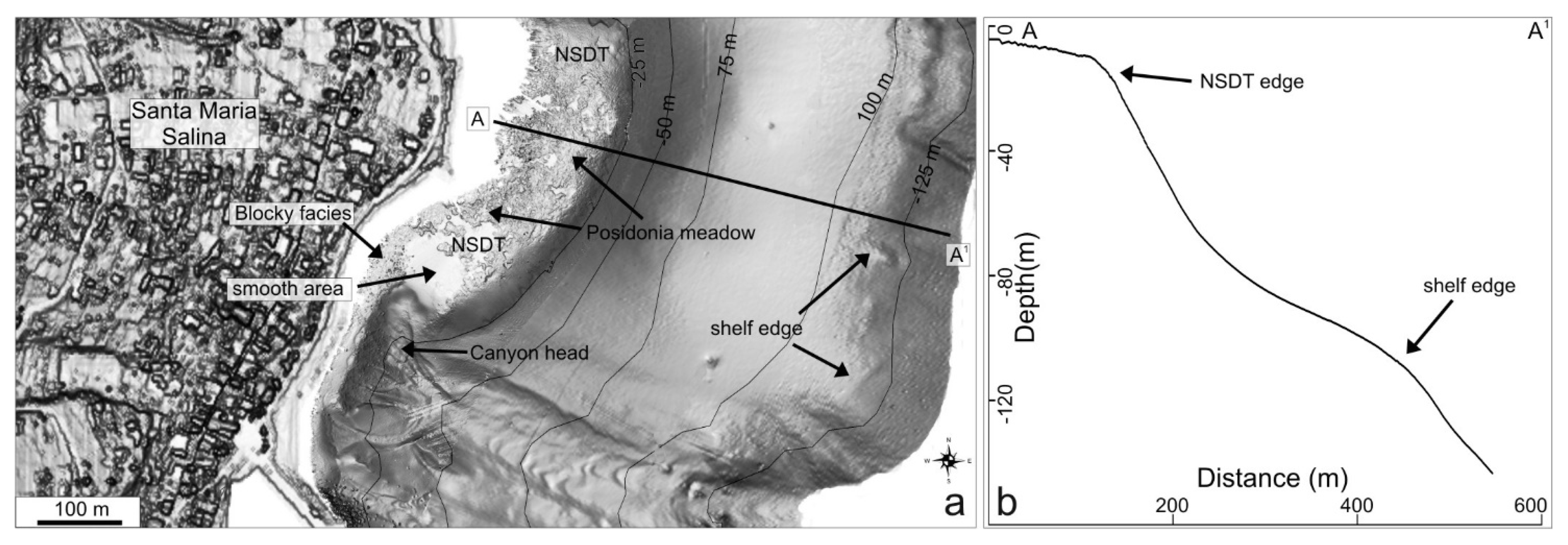
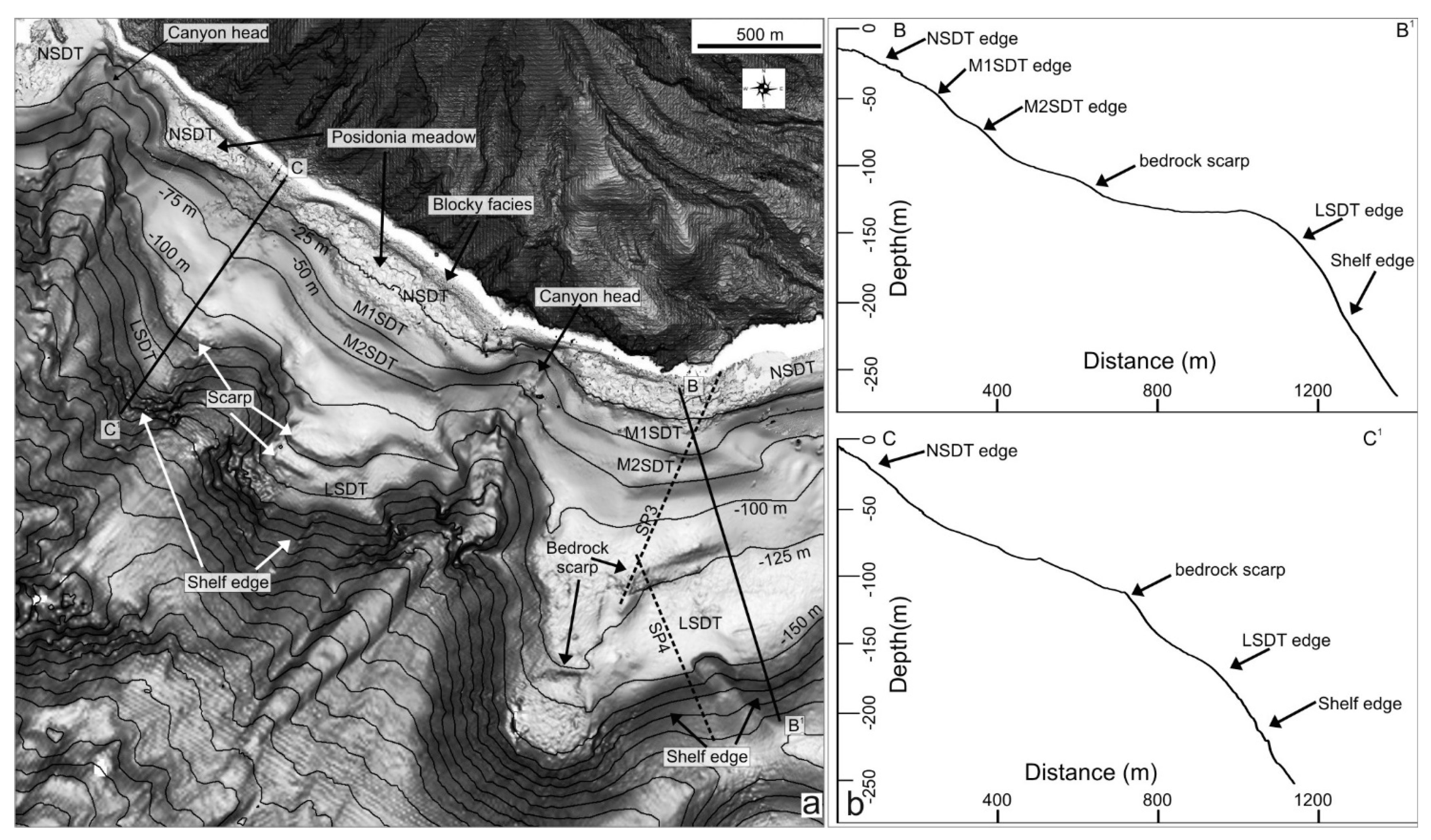

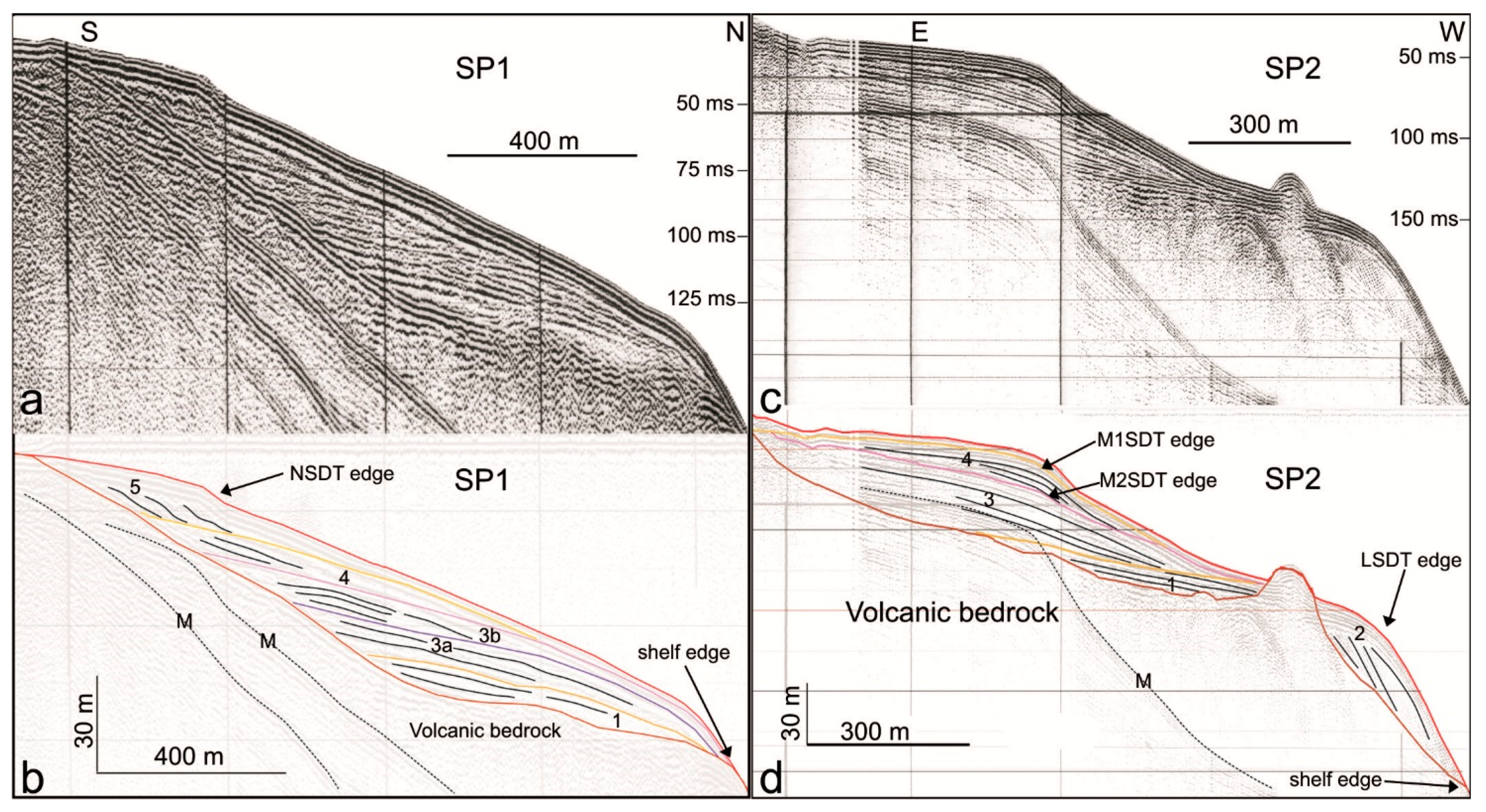
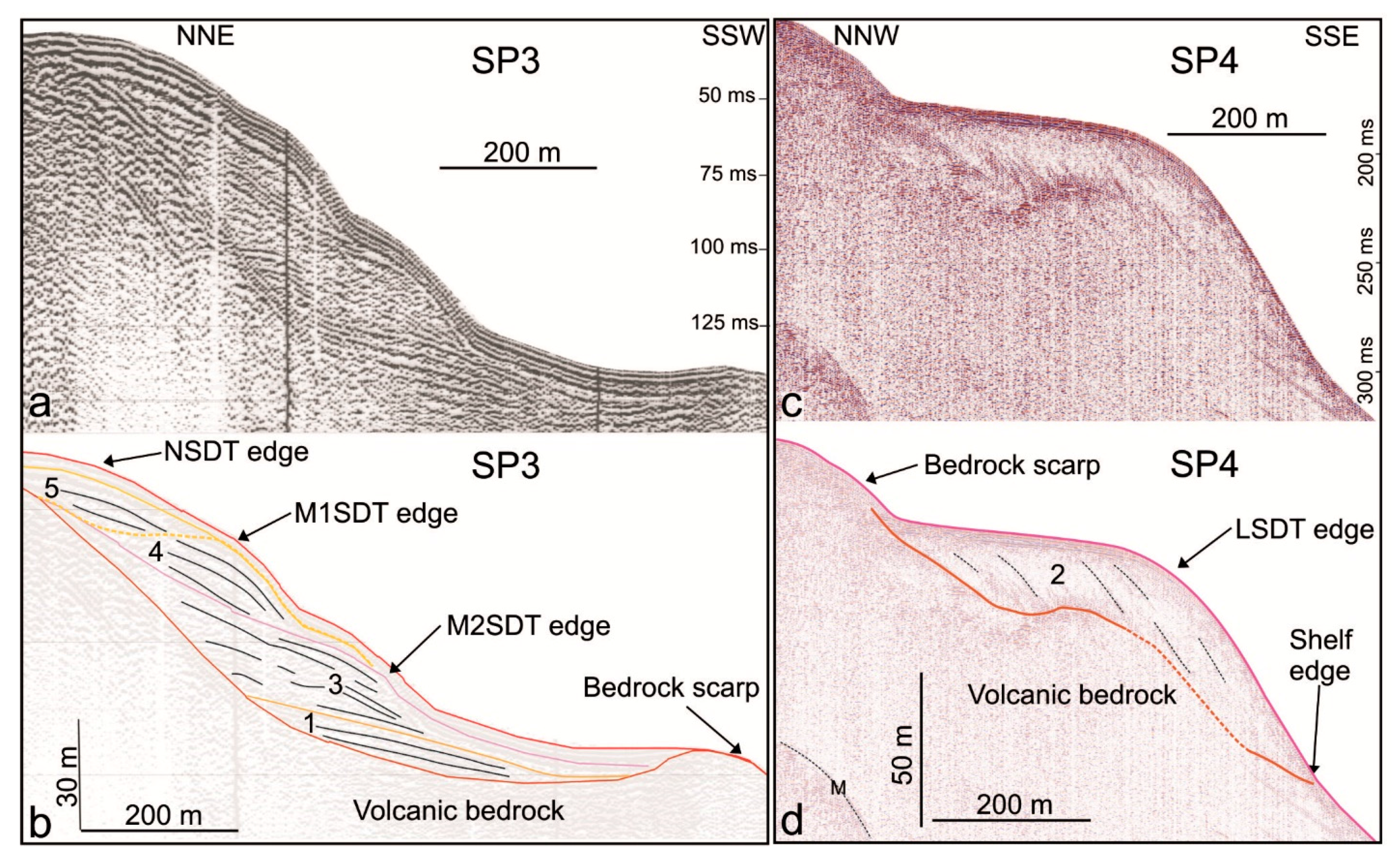

© 2018 by the authors. Licensee MDPI, Basel, Switzerland. This article is an open access article distributed under the terms and conditions of the Creative Commons Attribution (CC BY) license (http://creativecommons.org/licenses/by/4.0/).
Share and Cite
Casalbore, D.; Romagnoli, C.; Adami, C.; Bosman, A.; Falese, F.; Ricchi, A.; Chiocci, F.L. Submarine Depositional Terraces at Salina Island (Southern Tyrrhenian Sea) and Implications on the Late-Quaternary Evolution of the Insular Shelf. Geosciences 2018, 8, 20. https://doi.org/10.3390/geosciences8010020
Casalbore D, Romagnoli C, Adami C, Bosman A, Falese F, Ricchi A, Chiocci FL. Submarine Depositional Terraces at Salina Island (Southern Tyrrhenian Sea) and Implications on the Late-Quaternary Evolution of the Insular Shelf. Geosciences. 2018; 8(1):20. https://doi.org/10.3390/geosciences8010020
Chicago/Turabian StyleCasalbore, Daniele, Claudia Romagnoli, Chiara Adami, Alessandro Bosman, Francesco Falese, Alessandro Ricchi, and Francesco Latino Chiocci. 2018. "Submarine Depositional Terraces at Salina Island (Southern Tyrrhenian Sea) and Implications on the Late-Quaternary Evolution of the Insular Shelf" Geosciences 8, no. 1: 20. https://doi.org/10.3390/geosciences8010020





